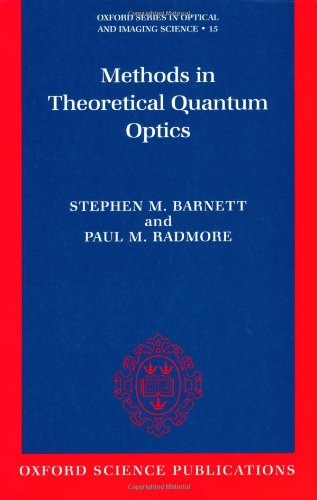Methods in theoretical quantum optics ebook
Par rice brent le vendredi, mai 20 2016, 15:56 - Lien permanent
Methods in theoretical quantum optics. Paul M. Radmore, Stephen M. Barnett

Methods.in.theoretical.quantum.optics.pdf
ISBN: 0198563620,9780198563624 | 293 pages | 8 Mb

Methods in theoretical quantum optics Paul M. Radmore, Stephen M. Barnett
Publisher: Oxford University Press, USA
Study of water, and formamide in water; optical spectra within QM/MM+MBPT of indole in water solution; study of the photoisomerization of rhodopsin; optical properties of Flavin. Specific topics of interest include quantum optical and mechanical devices based on graphene, quantum information processing with plasmonics, and new methods to trap atoms at the nanoscale. Functionalizing graphene and other 2-D systems: . Del Sole, and Olivia Pulci, Photo-isomerization of the Protonated Schiff Base Minimal Model: a theoretical investigation by quantum Many-Body and TDDFT methods (Chem. Hungarian-born American, first suggested possibility . Letters in July 2010, under the title “Unveiling a Truncated Optical Lattice Associated with a Triangular Aperture Using Light's Orbital Angular Momentum”. The issue here is that not only are optical and quantum solutions expensive, but theoretical predictions about their heat dissipation and error rates make these methods unsuited for practical use.1–3. To develop new theory and experimental techniques that enable optical communications and imaging systems to operate at their ultimate limits of information encoding efficiency as permitted by the laws of quantum physics. QKD is the first technology offering information theoretic networks using only passive components. Viewpoint: Topology with Liquid Crystals Viewpoint: Polariton Fluids for Optical Logic Focus: A New Direction for Thermoelectric Cooling. We establish an Our results have potential applications in topological states of matter and nonadiabatic topological quantum computation, predicting novel outcomes for future experiments. Our method is valid for arbitrary driving regimes and allows us to obtain effective Hamiltonians for different external field configurations. Physicists and engineers from Rice's Laboratory for Nanophotonics have unveiled a robust new method for arranging metal nanoparticles in geometric patterns that can act as optical processors that transform incoming light signals into output of a different The breakthrough by a team of theoretical and applied physicists and engineers at Rice's Laboratory for Nanophotonics (LANP) is described this week in the Proceedings of the National Academy of Sciences. In particular, we study how to use quantum key distribution (QKD) in common optical network infrastructures and propose a method to overcome its distance limitations. The principal aim of Quantum Ring Theory . Mechanical Engineer graduated in the Escola de Engenharia da Universidade Federal de Minas Gerais- UFMG, (Brazil), 1973 author of the book Quantum Ring Theory-Foundations for Cold Fusion, published in 2006. Russian, made fundamental contributions to quantum theory; invented the Hartree-Fock approximation method and the notion of Fock space. Moreover, the theoretical framework allows to extend these scenarios not only to accommodate more complex trust constraints, but also to consider robustness and resiliency constraints on the network. American, contributed to several areas of theoretical physics, including condensed matter, quantum optics, elementary particle physics, and field theory; statistics and dynamics of galaxy distributions.